
Spiritually Seduced by the Last Shangri-la. Bhutan (Part 1)
Paro International Airport Bhutan (aerial view)
Beyond that magical place where the sky and the earth meet, there lies a mystical Himalayan Kingdom, Bhutan. As we journeyed last week through Druk Yul or the land of the Thunder Dragon, we experienced an almost unimaginable spiritual awakening.
Captivated by the sheer beauty of this mountain jewel and its affable people, we were delighted to learn that Bhutan is the only country in the world to have officially adopted Gross National Happiness as it’s main development indicator.

A direct flight from Mumbai to Paro on Druk Air, we were impressed with the inflight service standards on the national airline of the Kingdom of Bhutan. The impeccably attired air hostesses were attentive, gentle and ever so polite while serving passengers. The flight time is a little over three hours and even though there is no in-flight entertainment on board one cannot help but appreciate the clean interiors, the good quality of crockery and cutlery and the delicious lunch served on Druk Air. On landing in Paro we peeked out of the airplane window and noticed the lush green mountains bordering the valley, the similarity of the houses all done up in a a traditional Bhutanese style, the unique main terminal building and the way the locals were dressed in what appeared to be their national dress. The air hostess informed us that local citizens were required to observe the national dress code during working hours. While Bhutanese men wore a heavy knee-length robe tied with a belt, called a gho, the women dressed in colourful blouses over which they folded and clasped a large rectangular cloth called a kira. A short silk jacket, or toego could also be worn over the kira. The hostess explained that the gho and kira worn daily were made from cotton or wool and were changed according to the season. For festivals and other special occasions, a silk Kira and gho were preferred by many.


Indian citizens do not require a visa for Bhutan and immigration is a breeze. Your passport is stamped on arrival for the exact number of days you choose to stay in Bhutan. My travel agent in Mumbai had said that on arrival, our guide and designated driver for the week long trip would be at the gate with our name board, waiting to welcome us. As we wheeled our trolley out of the airport’s arrival lounge, my eyes scanned every name board present. Sadly, our guide and driver were not to be found. A kind Bhutanese gentlemen noticed that I was anxious and asked which hotel I was staying at? I said that we were guests at the Taj Tashi at Thimphu. He pointed to a lady and said that she was from the Taj. I immediately went up to her and introduced myself. This was the first we saw of Rinzin Lhamo, the guest relation manager at the Taj Tashi. She was there to welcome a VIP guest, the wife of the Tata group chairman, Mr Cyrus Mistry. Rinzin’s presence at the airport worked in our favour. She was quick to make us feel comfortable, assuring us that even though we had not booked hotel transportation, a hotel vehicle would nonetheless be made available to us since our designated guide and transport was late to arrive. She called my guide who said that he was still a half hour away as he had some vehicle trouble. This could have been an unwelcome start to a holiday both Laveena and I were truly looking forward too, had it not been for the amazing Rinzin. She sprung into action, walked us to a hotel vehicle which was at the airport to fetch another guest and sent us on our way, politely assuring us that the original vehicle meant for us would be used to transport the other guests who were due to arrive on a later flight. Upbeat with this now positive beginning to our holiday, we started on our journey from Paro to Thimpu and along the way absorbed the wondrous sights of this incredibly beautiful country. Our driver told us that the total population of Bhutan was only 700,000 and that the local people loved the royal family. He told us that the 4th King in 2008 had given up his throne in favour of his young 28 year old son, Jigme Khesar Namgyel Wangchuck. At this time the country moved from absolute monarchy towards a constitutional Monarchy and held it’s first general election. As we drove to the capital city, along the way we saw locals in their national dress, grazing cows, azure blue flowing rivers and homes with multi-colored wood frontages, small arched windows, and red chilly drying on the top of their sloping roofs.


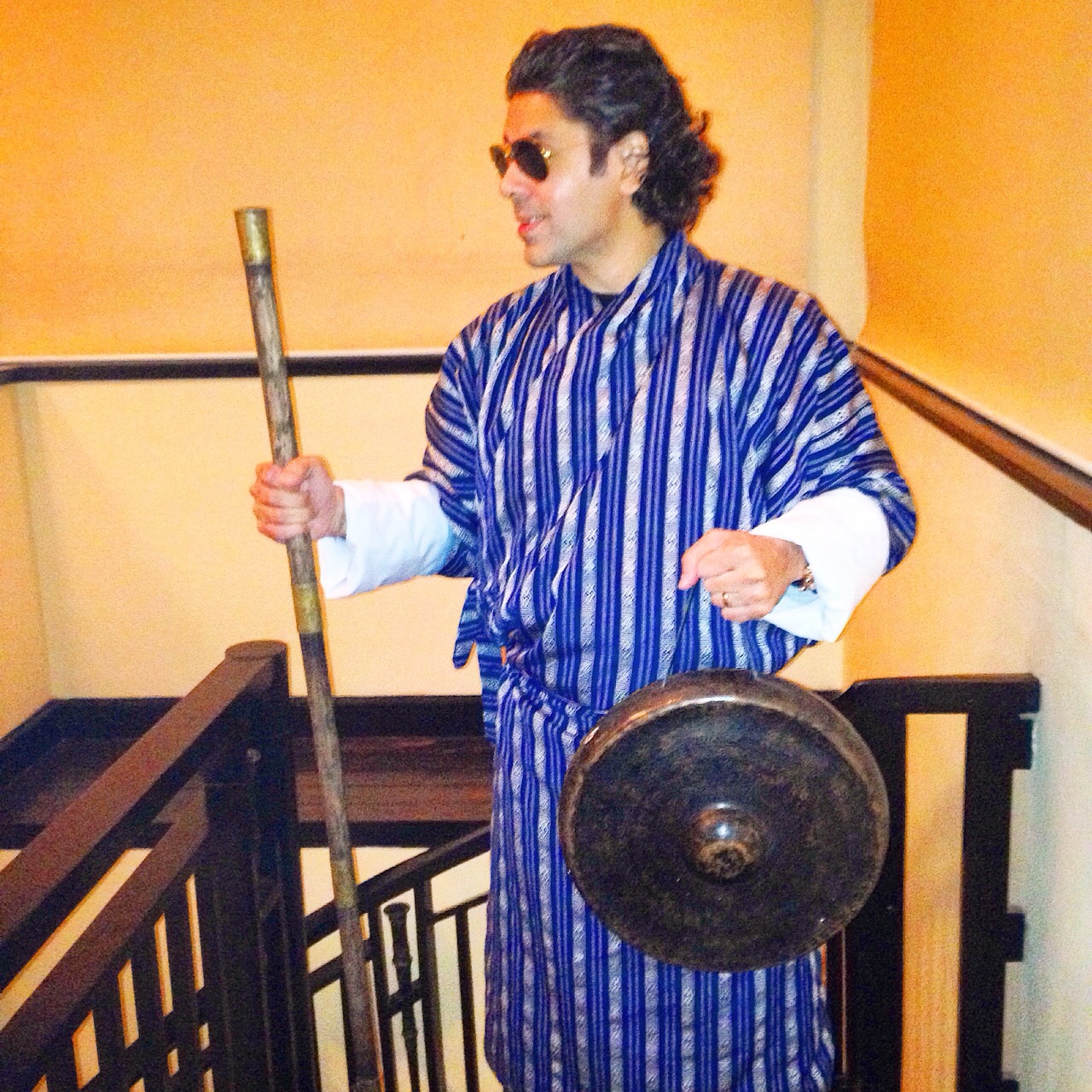
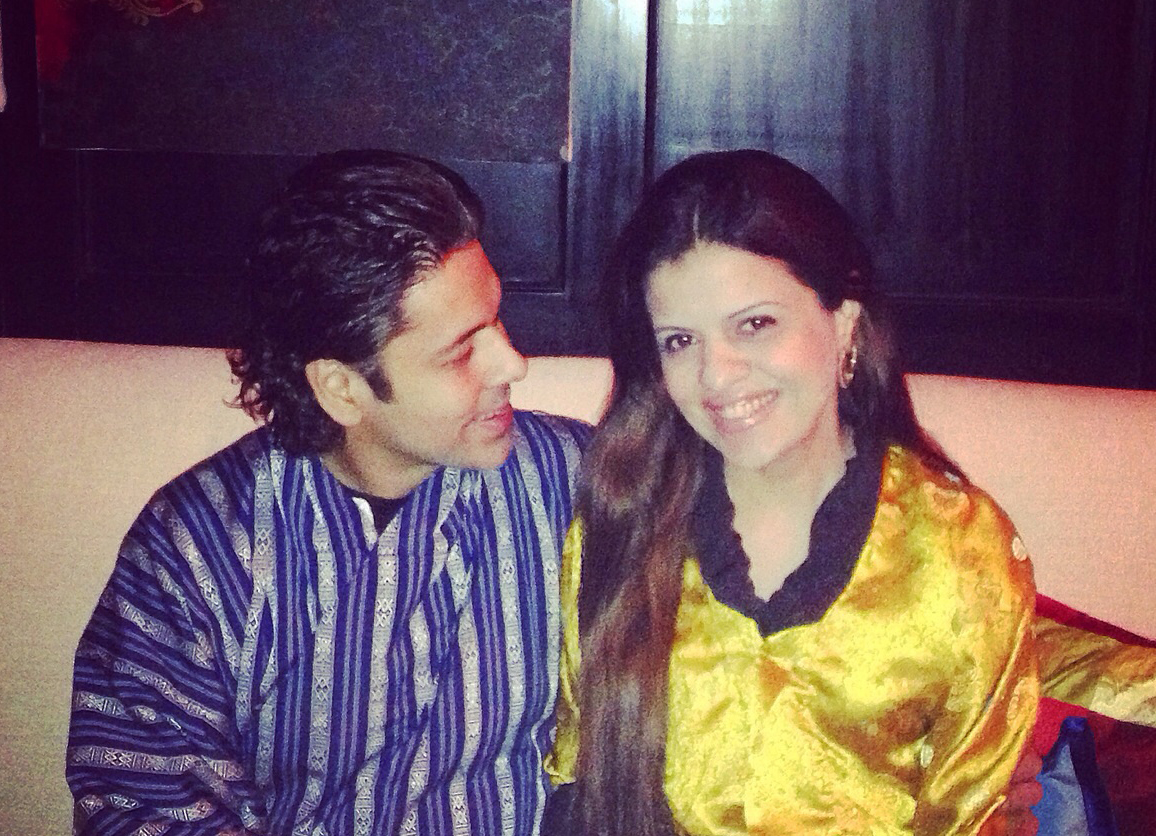
Chig-Ja-Gye Restaurant (Taj Tashi )
A little over an hour later we arrived at the magnificent Taj Tashi where the hotel staff were waiting to welcome us. A Tashi Khaddar (a traditional white scarf) was placed around our necks and we were offered an absolutely delicious welcome tea with ginger, mint leaves, cinnamon and honey. Located in the heart of the Thimphu Valley, the Taj Tashi is a hotel which reflects Bhutan’s Dzong Architecture. The hotel has 66 elegantly decorated guest rooms, many of which offer spectacular views of the surrounding mountains. After a brief introduction to the hotel's young and dapper General Manager, Mr. Sibi Mathew, we were checked into the duplex suite by Sonam, the receptionist. We immediately embraced and appreciated her kind, warm and gentle hospitality. For every request we had, Sonam politely responded with a ‘certainly’. That evening dinner was at the Chig-Ja-Gye, a restaurant specialising in Bhutanese cuisine. Rinzin called to say that to truly enjoy the local flavours we should dress in Bhutanese attire and for this, a Kira and a Gho were sent up to our room. Sonam helped us dress for dinner. The local attire looked arrestingly elegant and truly made us feel special. As we walked to the restaurant we noticed that the walls of the Taj Tashi were adorned with hand drawn murals of Buddha. At the restaurant, the space was decorated with horn instruments and gold leaf paintings. We were told that Chig-Ja- Gye represents 108 principal temptations in Buddhism. Mr. Vikram Patil, the immensely talented FNB Manager, who had helped set up the kitchen at the Taj Bekal, informed us that the evening’s spread had been pre ordered by executive Chef Arun Kumar Reddy. We had limited knowledge about the local food but found Bhutanese food to be both palatable and interesting. The vegetables were fresh, the seasoning, light, the local meats tender and the soup quite delicious. Overall it was a gastronomical experience we were glad we had, with the highlight being the delicious local sweet dish which we shamelessly wolfed down and called for a second helping.

We awoke the next morning to enchanting views of the Thimphu valley from our bedroom. In the duplex suite at the Taj Tashi, the bedroom is on the upper level while the living room is located on the level below. Separating the two is a long winding wooden staircase which is not ideal for senior citizens in my opinion. However, we did enjoy the space and the breathtaking views from our room. Breakfast was at The Thongsel, the all -day coffee shop, where a delicious spread awaited us. Laveena has a wheat allergy, but the hotel was pre-informed and hence well prepared. They served her gluten free breads with her freshly cooked eggs. We were also very pleased to see a live dosa counter. Punitharaj Devaraj, the junior Sous Chef served us perfectly browned, crisp plain dosas with yummy chutneys. From where we were seated we had a magnificent view of the prayer wheel or Khor which is on the hotel property. On the wheel are encapsulated prayers, mantras and symbols. According to the Bhutanese Buddhist tradition, spinning such a wheel will have much the same effect as orally reciting the prayers. A majority of Bhutanese people follow Vajrayana Buddhism while many also follow Mahayana Buddhism. These culturally alluring forms of the faith are seen richly intact and followed till date.


Royal Textile Academy


Post a leisurely breakfast we were ready to set out sight seeing. Our young and knowledgable guide Vijay and our skilful, experienced and articulate driver Topgey were to be our travel companions for our week long adventure across this breathtakingly colorful, remote and uniquely charming Shangri-La. Our day began with a visit to the Textile Museum. Dedicated to the rich skills of the Bhutanese weaver, the museum is well worth a visit as it demonstrates the talents of the traditional method of weaving cloth. The museum also showcases a collection of rare pieces belonging to the royal family. This was followed by a visit to the Folk Heritage Museum, built in the form of a traditional Bhutanese house. As we walked through the house we experienced local habits, rural traditions, demonstrations of ways of husking rice, brewing spirits and extracting oil. We were then driven to Changangkha Lhakhang, a temple established in the 12th century on a site chosen by Lama Phajo Drugom Zhigpo. The central statue is that of Chenrezig, the Buddha of compassion. We noticed that Vijay our guide put on a a white sash (kabney) from his left shoulder to the opposite hip. This we were told was a compulsory addition to the Gho for males before entering a temple or a Dzong. Women on the other hand had to wear a narrow embroidered cloth draped over the left shoulder, a rachu.
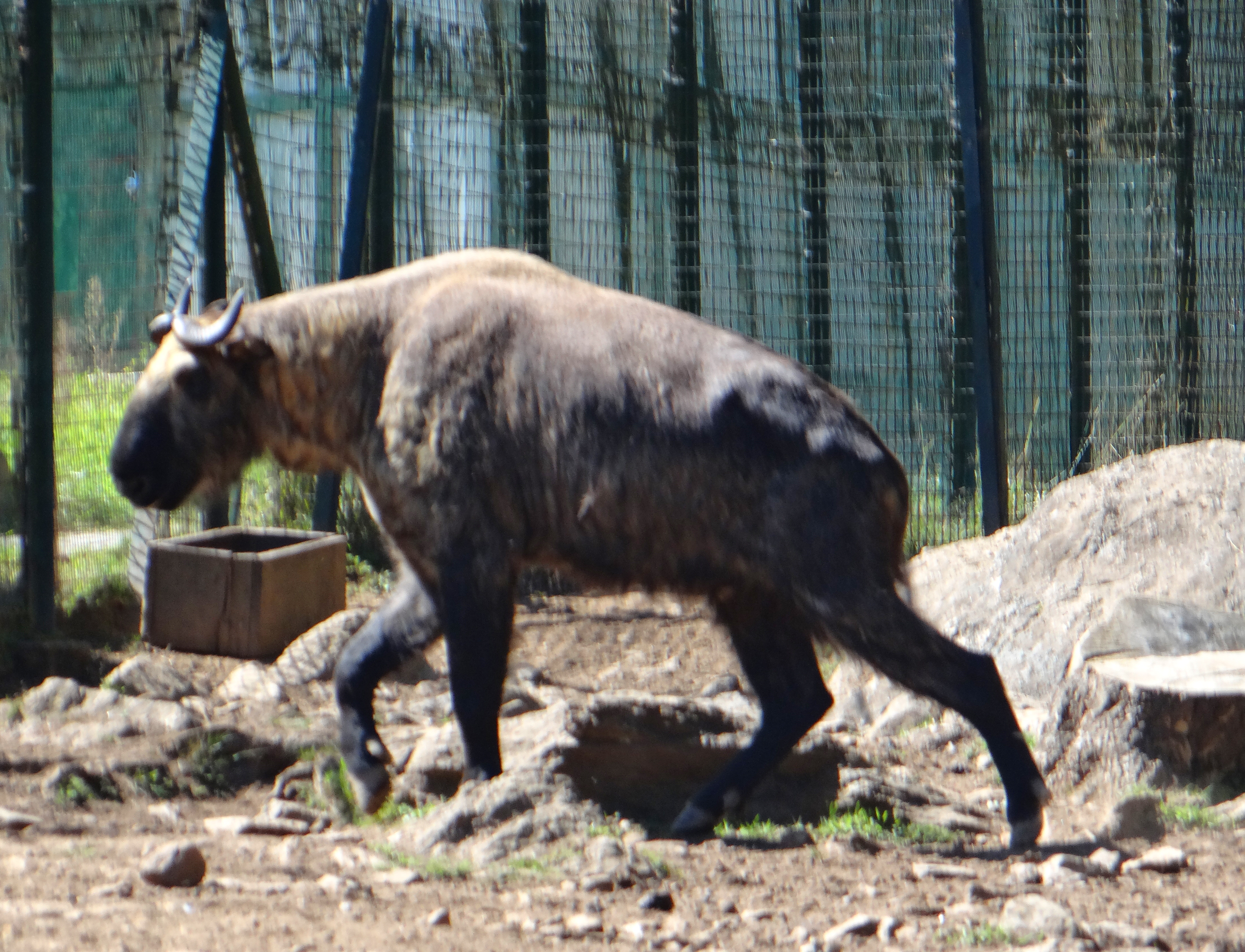
We drove on to the Takin reserve where we saw the national animal of Bhutan, the ‘Takin’. The Takin has the body of an antelope and the head of a goat. Legend has it that a Tibetan saint, Drukpa Kunley, known as “The Divine Madman” was asked by the people of Bhutan during one of his religious talks to perform a miracle. While he agreed to do so, he first said that he wanted to be fed lunch. A whole goat and an antelope were brought to him. After eating them both, the Saint, took the head of the goat and fixed it to the body skeleton of the antelope following which he snapped his fingers and magically, a live animal with the head of a goat and the body of an antelope sprang up and headed to the hills to graze. This animal was called a Takin and has since been adopted as the National Animal of Bhutan.
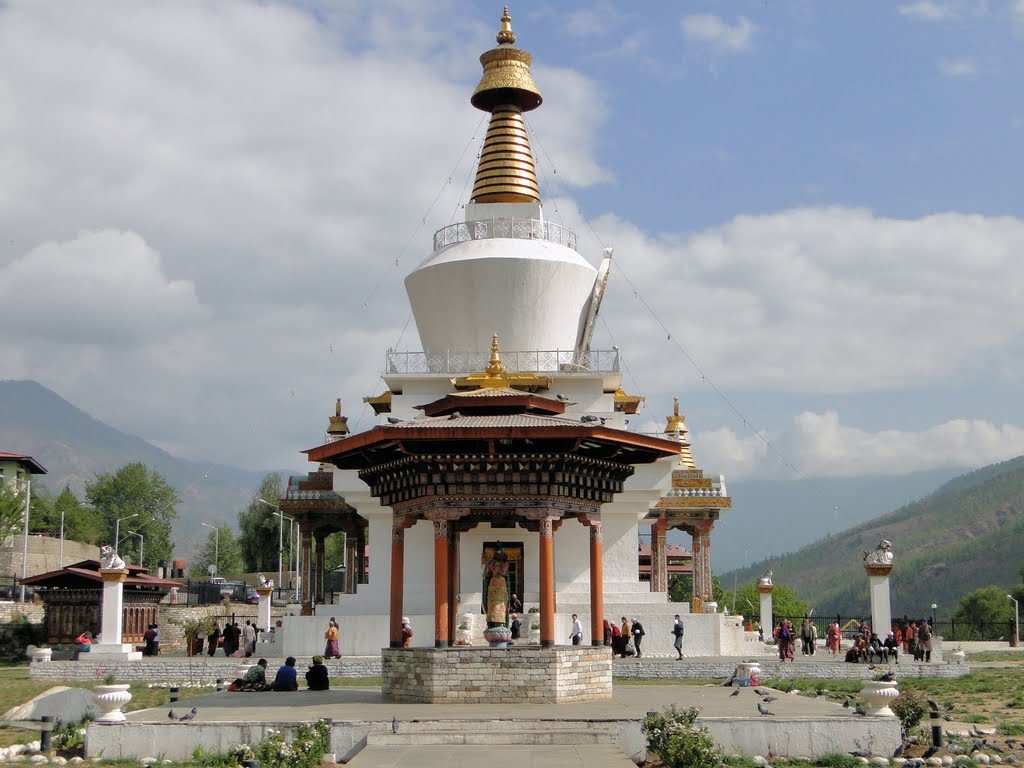
Later that day we visited the Handicraft emporium and the memorial chorten, a monument dedicated to world peace and prosperity. The structure was originally conceived by His Majesty Jigme Dorji Wanghuck, the father of Modern Bhutan. Sadly the King died before the completion of the monument.
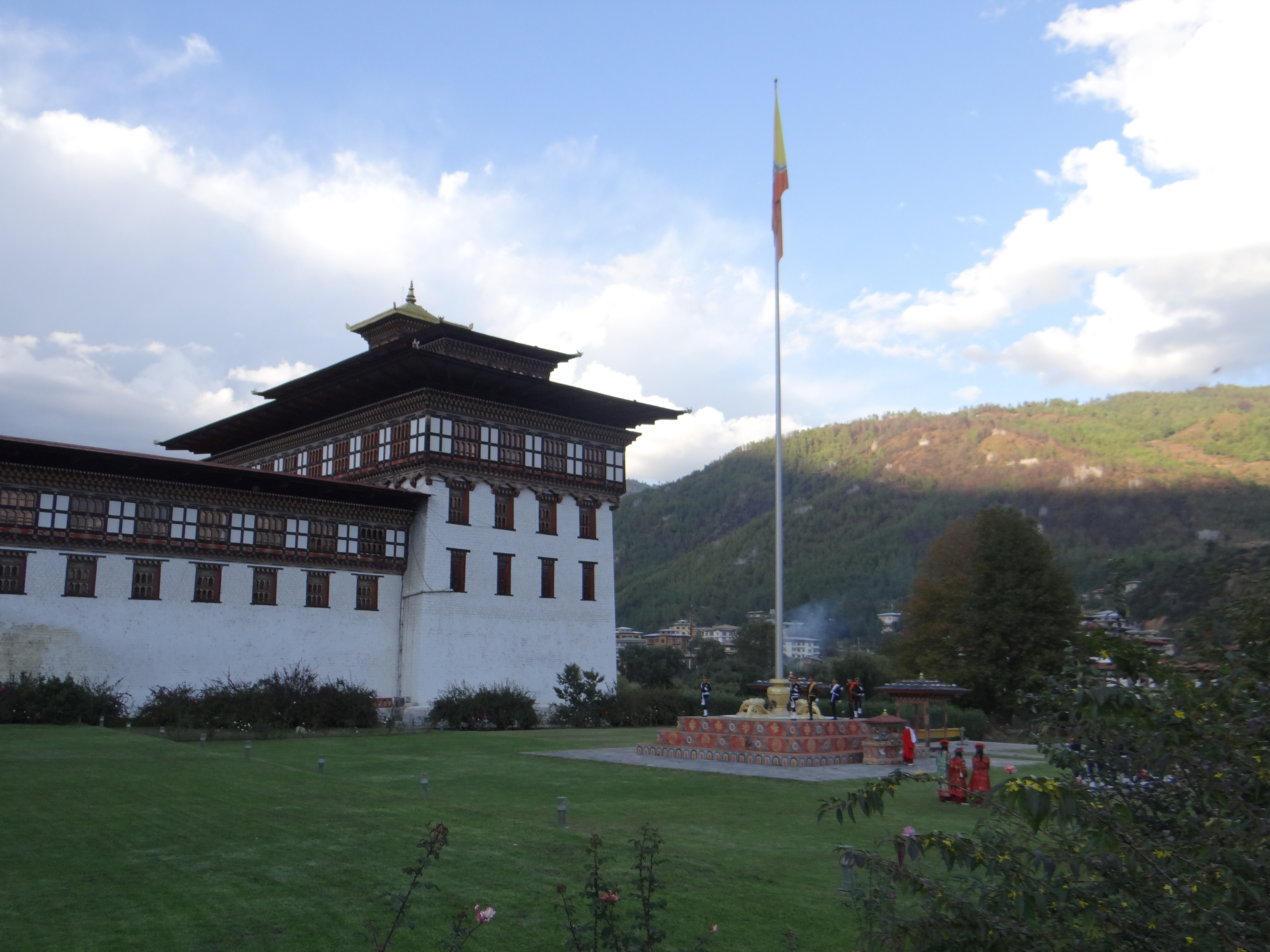

Tashichho Dzong- The Fortress of the Glorious Religion
At 5 pm we drove out to the Tashichho Dzong, also known as the fortress of the glorious religion. The Dzong houses the Throne room of His Majesty the King of Bhutan. We witnessed a magnificent parade and the unfurling of the Bhutanese flag at the Dzong.

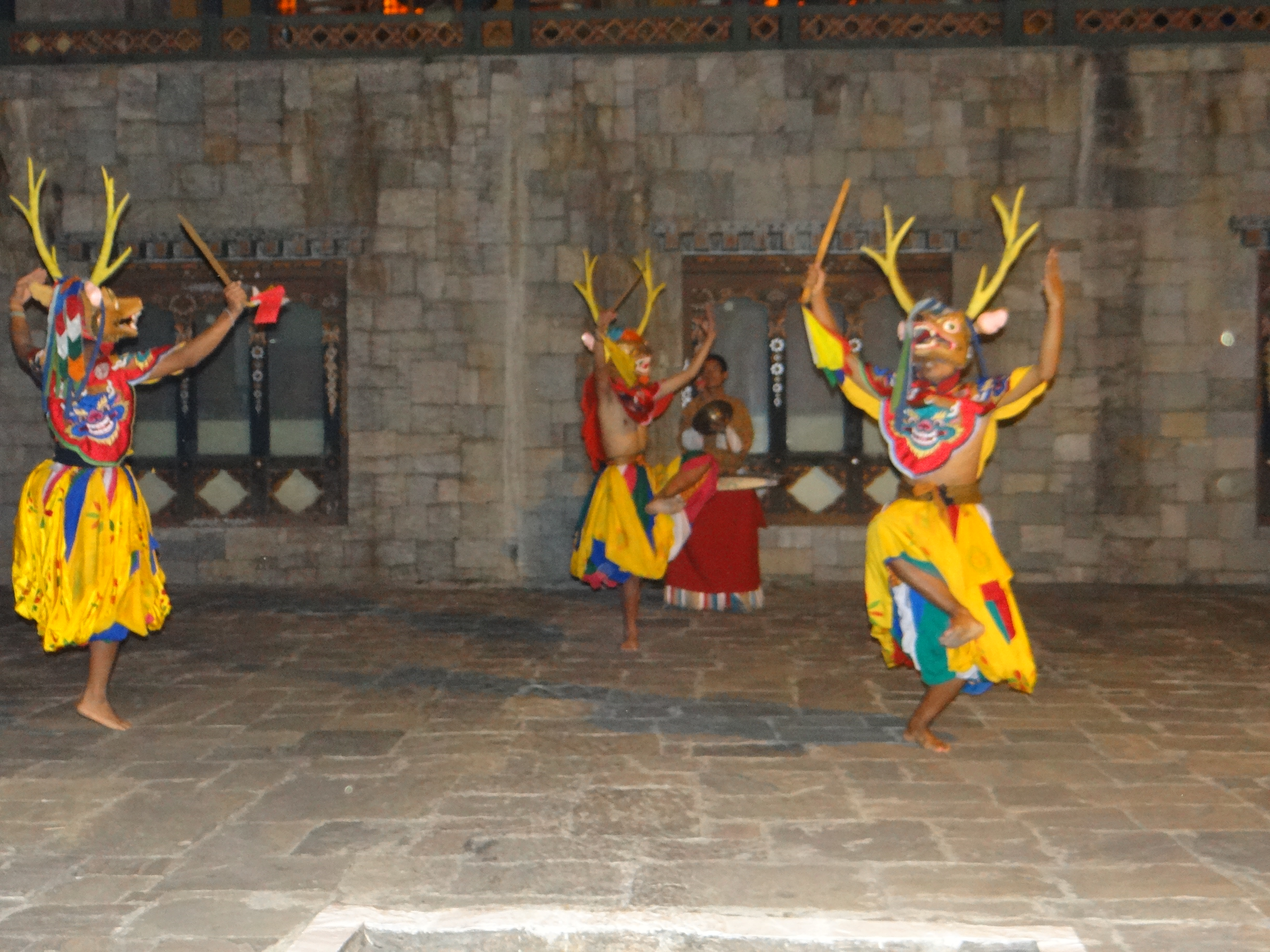
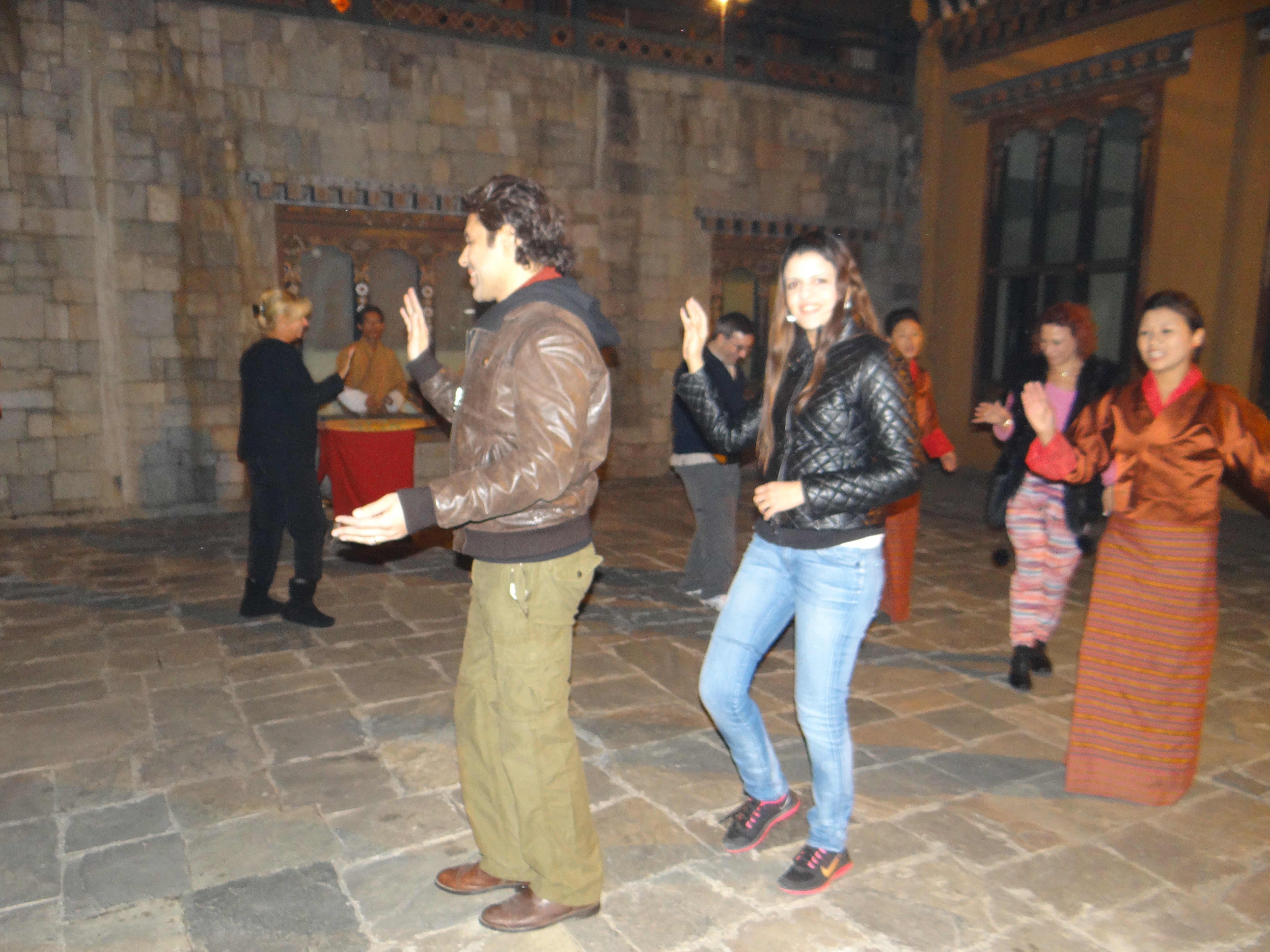
The Drametse Ngacham
That evening, we were invited to experience centuries of tradition come alive through a performance in the courtyard of the Taj Tashi. Rinzin who never seemed to tire, was there to guide us to the courtyard where the festivities were ready to enchant us. Before she directed us to the courtyard, she presented us with local stamps which had our picture on it. This came as a huge surprise as neither Laveena nor I had ever been on a country stamp before and we felt deeply privileged to see ourselves on the local stamp. Once at the courtyard, we sat around a fire with our newly found friends from England, Paula and Daren Burney, Joanne Osen and Gideon Paul. The evening started with the performance of the Zhungdra, one of the oldest classical songs performed in the Monsastries and Dzongs of Bhutan. The women who sang for us looked resplendent in their national dress. This was followed by The Mask Dance (Drametse Nga Cham) and the Layab, the dance of the nomads. A religious dance called the Shazam Cham followed. The Thrung Thrung, the dance of the black necked crane was haunting as the ladies danced to the tune of the Uangchen (Dulcimer) and the Dramnyen (lute). In the farewell dance, Tashi Tashi, the audience were invited to join in and ample fun was had by all as we tried to match the local dancers step for step and took in the mellifluous tunes of the Chewang (fiddle) and the Lym.
Our dance was followed by an early dinner post which we retired to bed in preparation for an early start the next morning to the Dochula pass where we were scheduled to stop on our way to Gangtey. ( this part of our adventure will be covered in my next feature)
Spiritually Seduced by the Last Shangri-la. Bhutan (Part 1)
• Location: Google Maps • Address: Samten Lam, Thimphu, Bhutan • Hotel website: Taj Tashi
Our Rating
- Location: 9/10
- Food and Cuisine: 8/10
- Design: 8/10
- Rooms: 8/10
- Service: 9/10
- Overall experience: 8/10
Articles you May Love To Read
Spiritually seduced by the Last Shangri-la. Bhutan (Part 2)
Spiritually seduced by the Last Shangri-la. Bhutan (Part 3)
Spiritually seduced by the Last Shangri-la. Bhutan (Part 4)
Follow me on Facebook , Instagram and Twitter for some amazing travel posts





